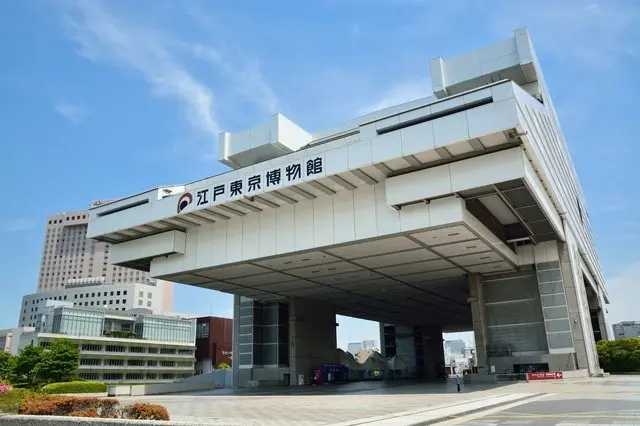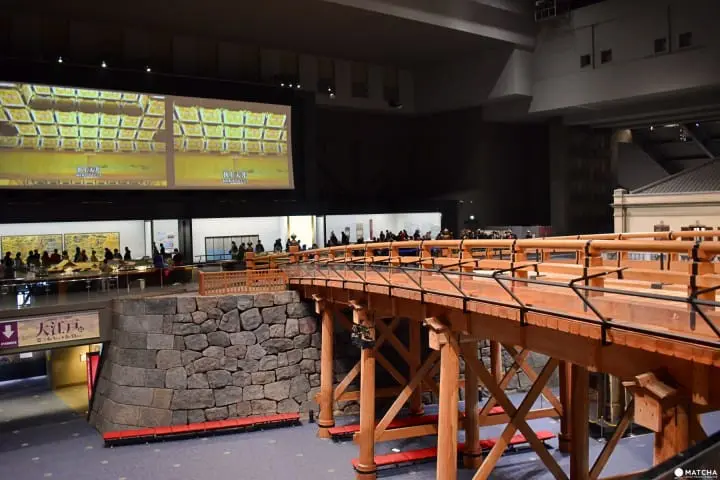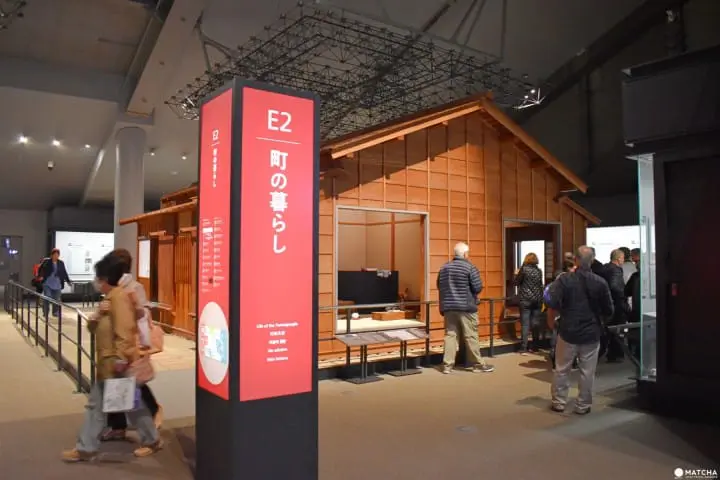Experience Old Japan! Edo-Tokyo Museum: Features and Highlights

The Edo-Tokyo Museum is where you can experience the vibrant culture of historical Tokyo and see how this metropolis flourished during the past four centuries. While the museum is closed for renovations until 2025, you can explore the exhibits via Hyper Edohaku, an interactive digital app.
Full of Fun! The Edo-Tokyo Museum

Photo by Pixta
The Edo-Tokyo Museum, located right next to the Ryogoku Kokugikan Sumo Hall, is a facility where you can experience what Tokyo used to be like during the Edo period (1603 - 1868).
The Edo-Tokyo Museum has won the hearts of visitors of all ages through its exciting interactive exhibits. The museum is currently closed for renovations until the spring of 2025. However, the exhibits can be explored via Hyper Edohaku, a free digital app available for download from both the App Store and Google Play.
Hyper Edohaku is available in two versions: the Edo-Tokyo Museum App, which offers access to virtual recreations of all the exhibits, and the Meiji-Ginza Edition, which focuses on recreations of Tokyo during early modern times.
There are other various ways of enjoying the museum before its reopening, including a YouTube channel and digital archives, so please visit the official website of the Edo-Tokyo Museum for details.
Edo-Tokyo Museum official website
Edo-Tokyo Museum Highlights
When you think of this museum, a slightly serious image may come to mind. However, the Edo-Tokyo Museum is an exciting museum full of fun gimmicks that will be reversing that very image of the term.
In order to enjoy the Edo-Tokyo Museum, we’ll split the permanent Edo Zone exhibition room into three sections – Walk, See, and Experience – and guide you through the highlights of the museum!
Table of Contents:
1. Walk Through a Full-Scale Edo
2. See the Nooks and Crannies of Edo
3. Experience the True Edo
4. Not Only the Edo Period!
5. Complete with Multilingual Support
6. Leisurely Enjoy Your Food
7. Japanese Goods as Gifts
8. How to Buy Tickets and Access the Museum
1. Walk Through a Full-Scale Edo
Travel Back in Time Through the Gate of Edo – Nihonbashi!

The first thing you’ll see will be a large wooden bridge stretched out before your eyes when you step into the permanent exhibition room. This is a reconstructed model of the Nihonbashi area in Tokyo which was built during the Edo period.
Nihonbashi was the starting point of a route called the Five Routes that connected the entire country during the Edo period and was an important bridge said to be the main way of transportation in Edo.
This model is a recreation made based on records of when the bridge was replaced during the latter half of the Edo period. Half of the north side of the bridge, a total of 51 meters, has been reconstructed here. Currently, the 20th-generation stone bridge built in 1911 is located in the area we know as Nihonbashi.
What you’ll see below as you walk on the bridge is the kabuki theater Nakamura-za (a reconstruction of the front of the building) that used to entertain the people in the town of Edo. Traditional performing art events are held regularly in front of this building.
Peek into the Lives of the Townspeople

Full-sized homes through which you will come to understand the lifestyle of the Edo people are also found here. These homes are called munewari nagaya (tenements of row houses) where one building is divided by walls, housing complexes where families would live in at the time.

Upon peeking inside, you’ll be surprised by the small size of the room. It is said that people lived in rooms that were four and a half tatami mats in width (about 7.45 square meters).
Due to the small size of their houses, families also thought of ways to store their belongings. For example, each person would eat on top of their own zen trays (*1) during meals. When they finished eating, they would place a lid on their tables and then stack them up to ensure that they had space.
*1 Zen: a small tray where one person’s tableware and portion of food would be placed.

This is the house of a craftsman who created furniture made with wooden boards called woodworking.
The demand for carpenters was extremely high as buildings during this period were wooden and would often result in fires. Even when houses were built, carpenters would anticipate the possibility of a fire and would purposely build houses so that they were easy to destroy to prevent the spread of the fire.
Sushi That’s Two Times the Size!?

This is a sushi stand. Sushi may have the image of being a luxury food these days compared to in the past, but it was a type of fast food during the Edo period. Citizens would drop by and fill their stomachs at these kinds of stands then go back to their business.

When you look at the display up close, the sushi is twice the size of modern sushi! It appears that this was the size of the sushi during those days.
As there were no such things as refrigerators back then, methods such as adding soy sauce to the sashimi were devised to prevent spoilage. The traditional style of sushi known as Edo-style sushi can be still enjoyed today.

This is a shop that sold items such as colored woodblock prints (a type of ukiyo-e). The theme of these once-popular prints included yakusha-e (prints of kabuki actors), prints depicting beautiful women, and sumo prints that portrayed sumo wrestlers.

You can also take a look at the creation process of these colored prints. Through this display, you’ll come to understand that ukiyo-e is actually made through several processes.
2. See the Nooks and Crannies of Edo
Miniatures You Won’t Get Enough Of

What we definitely want you to look at closely at the Edo-Tokyo Museum are their miniatures. Inside the museum are elaborately scaled models that recreate scenes from the Edo period through which you can take a look into the daily lives of the people during that period.
The photo above is a recreation of the townscape near Nihonbashi from the beginning of the seventeenth century made on a 1/30 scale. Each and every figure is filled with expression while the house interiors and designs of the clothes are recreated down to the finest details; you absolutely won’t get tired of looking at them.
There are, unbelievably, 800 figures in total in this miniature model with each and every one of these figures being handmade!

You can observe the miniatures with even greater detail using the binoculars available.

When you look at the display through the binoculars, you’ll feel as if you’ve been brought back in time to that very place.

This is a model recreated in a 1/10 scale of the inside of a kimono store called Mitsui Echigoya. Currently, Nihonbashi Mitsukoshi Main Shop, Japan’s oldest department store which descended from Mitsui Echigoya, is operated in Nihonbashi.
There are scaled models everywhere inside the museum including those of the daimyo’s (feudal lord) mansion and the scene of a festival, so please be sure to thoroughly look at the displays and enjoy the detail put into them.
A Reconstruction of the World of Kabuki

A life-sized stage that represents “Sukeroku”, a traditional kabuki play, is also found here. Sukeroku’s pose, the protagonist of the play, reflects the pose made known by the famous kabuki actor Danjuro Ichikawa.

The stage settings, props, and costumes of the actors in this display have been created by a craftsman who works with kabuki stages. The “wigs” on the heads of these figures are also a particular feature that is rearranged every year by a craftsman who is responsible for the wigs in actual kabuki performances.

You can listen to the lines and music from “Sukeroku” when you press the button on the device set at the front of the stage. From the audio, you'll be able to understand the atmosphere of a true kabuki performance and the beauty in the tempo of the words that are spoken.

Starting from the latter half of the Edo period, various gimmicks were performed on stage in kabuki theater. A play called “Tokaido Yotsuya Kaidan” (The Ghost Story of Yotsuya) has been recreated for visitors to learn about the mechanisms used in theater such as the actors’ brief disappearing stage trick found in the play or the appearance of the ghost.
3. Experience the True Edo
Wandering around and looking at this space that has recreated the Edo period, you might have questions like “I wonder what it would feel like if I were to actually step inside?” or “I wonder how heavy that outfit must’ve been?” In order to answer those questions, experience-type displays where you can actually experience and touch Edo period objects yourself are located everywhere throughout the museum.

This is a life-sized palanquin for a daimyo (feudal lord). A daimyo would sit and ride inside this palanquin while traveling as four people carried him. You can actually take photos inside the palanquin!

This is a fireman’s flag pole. It is a landmark flag used at the scene of a fire. Firefighting organizations were created by the townspeople in the Edo period and, during a fire, this flag pole was used to let others know which organization was in charge of extinguishing the fire at the scene.
The pole weighs no less than fifteen kilograms and is quite difficult to lift, but the decoration at the top called baren (decorative long strips of leather) will beautifully spread outwards when you spin the pole.

There were merchants that would walk around the towns of Edo selling products such as fish or vegetables in baskets such as these. You are able to actually touch and lift this display.
The contents of the baskets will change depending on the season, so please take a look at what’s inside. It was April at the time when this article was written, so fish caught during the spring were placed inside.
4. Not Only the Edo Period!

Up until now, we’ve introduced exhibitions in the Edo-Tokyo Museum with the theme of walking, seeing, and experiencing, but what we’ve introduced is only half of the exhibitions in the museum!
Inside the Tokyo Zone, the remaining half of the exhibition space, are rows of complete exhibitions that depict scenes from the end of the Edo period to modern times.
There is also a lineup of very interesting exhibitions, such as a model of recreated buildings from the Meiji period, the period when Japan was influenced by European culture, where you can extensively experience Japanese culture.
5. Complete with Multilingual Support

Those who want to learn about the contents of the exhibitions in greater detail can utilize the audio guide receiver shown in the photo above to listen to explanations on every corner and model found in the permanent exhibitions.
A 1000 yen deposit is required but will be refunded once you return the receiver. The audio guide is available for rent at the entrance of the permanent exhibitions on the sixth floor.
You can also further enjoy the exhibitions in depth by going around the museum with an Exhibition Volunteer Guide. The tour is free and is available in various languages. The languages available that day will be posted at the entrance of the permanent exhibitions, so please be sure to check the bulletin.
The exhibition tour requires about one hour and 30 minutes to two hours and is available from 10:00 – 15:00.
6. Leisurely Enjoy a Delicious Meal

Now, you might be hungry after looking at all of these great exhibitions. You can spend your time leisurely here as restaurants and cafés can be found inside the museum. In addition to Sakura Saryo found on the seventh floor, a new restaurant called Ginza Western Cuisine Mikasa Kaikan and Café Mikasa were opened in April 2018 on the museum’s first floor.

Picture courtesy of Edo-Tokyo Museum
Mikasa Kaikan is most famous for its Chicken Doria (1450 yen plus tax). This restaurant mainly focuses on Western cuisine.

Picture courtesy of Edo-Tokyo Museum
If you want to eat Japanese cuisine, then head on over to Sakura Saryo. The Daimyo Bento (2800 yen plus tax) pictured above is a Japanese menu that you can enjoy to your heart’s content with sashimi, tempura (lightly battered deep-fried foods), and more.
Sakura Saryo is located on the seventh floor and is said to be about the same height as the castle towers that once stood at Edo Castle. You’ll be able to spend your time comfortably here while thinking of the Edo period.
7. Japanese Goods as Gifts

There are two museum shops located inside. Well-selling products include hand towels with traditional Japanese designs, handkerchiefs, and more. These products can be obtained starting from under 1000 yen, so how about getting these items as souvenirs if you find a design that you like?
You’ll also be able to find original products sold only at these shops such as the Castella-yaki (324 yen plus tax) filled with either anko (red bean paste) or custard cream.
8. How to Buy Tickets and Access the Museum
Once you exit Ryogoku Station and continue in the direction of the Edo-Tokyo Museum, you’ll find notice boards pointing to the museum.
Climb up the stairs to go to the permanent exhibition room, then purchase tickets at the ticket office on the third floor (they can also be purchased on the first floor). Please read the information available at the end of this article for ticket prices and business hours.
The Edo-Tokyo Museum has a total of seven floors with the first floor consisting of special exhibitions. The fifth and sixth floors are where you can find the permanent exhibitions.

This escalator is the entrance to the Edo period! The fun Edo Zone will begin once you go up to the sixth floor!
Visit the Edo-Tokyo Museum to Experience Edo!

The Edo-Tokyo Museum overturns the image of museums being a “facility where you look at documents in glass cases on display in silence.” It’s a place where you can witness the vibrant culture of Edo-Tokyo while experiencing it for yourself.
Do visit the exciting Edo-Tokyo Museum where time will go by in a flash before you realize it.
Hotels near [Closed] Edo Tokyo Museum
This is the official account of MATCHA's editorial department. Our articles feature useful travel information for visitors to Japan, from how-to guides to recommended places to visit.


![[Closed] Edo Tokyo Museum](https://place.matcha-jp.com/resize/200x2000/2023/09/25-17-35-02-127e4b0b2f5192303ef333c3e2698067d0.webp)









































![[2026] Top 5 Strawberry Picking Spots in Tokushima, Naruto| Farms and Access Guide for January to May](https://resources.matcha-jp.com/resize/720x2000/2025/03/06-227165.webp)
![[Yamanashi/ Hokuto City] 4 Hot New Spots Opening in 2026](https://resources.matcha-jp.com/resize/720x2000/2025/12/12-252747.webp)


